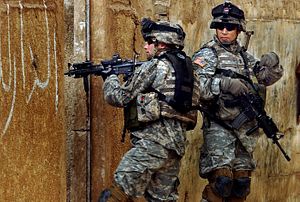A few defense and security links to start off the week:
The biggest news from the Pentagon this week is Secretary of Defense Chuck Hagel’s new budget plan, which is designed to refit U.S. armed forces in a manner suitable for emerging threats. Informing Hagel’s thinking on the budget is the looming drawdown from the United States’ longest ground war ever – Afghanistan. Consequently, the proposed budget would see the U.S. Army reduced in size to pre-World War II levels. The specific numbers on the horizon for the army would be around 440,000-450,000, down from a post-9/11 peak of 570,000. The size reduction departs from U.S. Cold War-era strategy, when the Pentagon vehemently pursued a budget that would allow it to fight two wars simultaneously. The cuts don’t stop at the army. The U.S. Air Force will lose its entire fleet of A-10 “Warthog” attack aircraft. The A-10’s greatest benefit was its ability to assist ground forces in combat. For the moment, the Navy looks like it’ll retain all 11 U.S. aircraft carriers, although Hagel has indicated that the USS George Washington could be on the chopping block should sequestration funding levels persist. Overall, the budget indicates that the Pentagon does not expect to engage in a land war anytime soon.
In other U.S. Army news, reports emerged over the weekend that the U.S. Army is working to initiate a formal dialogue with China’s People’s Liberation Army this year. The charge is being led by General Raymond T. Odierno, Army chief of staff, who sees the effort as an exercise in “managing differences constructively.” Odierno was in China this weekend where he was hosted at the Shenyang Military Regional Command in the country’s northeast by PLA Lieutenant General Wang Jiaocheng. No official dates have been set for the first meeting, but it appears that both sides are enthusiastic about the prospects of expanded military-to-military contact.
Iran will sell $195 million in light weapons and ammunition to Iraq. The revelation comes “according to documents seen by Reuters”–an agreement was reached in November 2013 between Iraqi Prime Minister Nouri al-Maliki and Iran for the sale. The Reuters report suggests that the deal is a direct result of the United States refusing al-Maliki’s requests for support against al-Qaeda associated militants. “We are launching a war against terrorism and we want to win this war. Nothing prevents us from buying arms and ammunition from any party and it’s only ammunition helping us to fight terrorists,” said one Iraqi government spokesman.
Australia will purchase eight Boeing P-8A maritime surveillance aircraft. The P-8A, in conjunction with high-altitude UAVs, is slated to replace the Royal Australian Air Force’s AP-3C Orions which are nearing their end-of-life.
If you’re a fan of the Naval Diplomat (as I am), you’ll want to check out his list of the five greatest aircraft carriers of all time over at The National Interest. Only three out of the five are American.

































